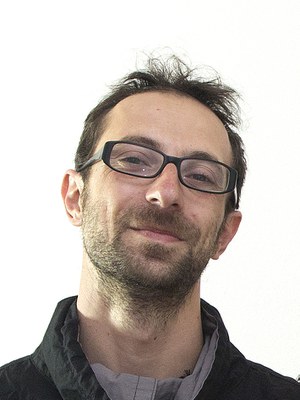Pasquale Francesco
XXXVIII Cycle IDAUP (A. Y. 2022-2023)
 Curriculum: Urban Planning
Curriculum: Urban Planning
Topic: 2.3 Territory, landscape ,and regeneration of the built-up environment: infrastructural interventions, new energy sources, and climatic change | 2.3 Territorio, paesaggio e rigenerazione del l'ambiente costruito: interventi infrastrutturali, nuove fonti energetiche e cambiamento climatico
Home Institution: University of Ferrara
Disciplinary sector:08/CEAR-09/B: Landscape Architecture
Main Supervisor: Prof. Theo Zaffagnini, DA Unife
Co-Supervisor: Prof. Xhimi Hysa, Polis University
ORCID ID: 0009-0008-3359-9474
SFERA ID: https://sfera.unife.it/cris/rp/rp14867
Concise CV (English version)
Francesco Pasquale obtained a Master's Degree in Architecture at the University of Ferrara in 2005, with a thesis in collaboration with the Delft University of Technology, in the Netherlands.
From 2006 to 2010 he worked for the firms Mecanoo Architecten in Delft and MVRDV in Rotterdam.
From 2011 to 2021 he was Adjunct Professor at the Department of Architecture of Ferrara.
From 2020 to 2021 he was Research Fellow at the Enzo Ferrari Department of the University of Modena and Reggio Emilia.
In 2021 he was elected in the Architect Council in Bologna, for the four-year period 2021-2025, as delegate for infrastructures, landscape and environment.
Since 2022 he has been a PhD Candidate in the IDAUP International Doctorate program of the University of Ferrara.
Concise CV (Italian version)
Francesco Pasquale consegue la Laurea Magistrale in Architettura presso l’Università di Ferrara nel 2005, con una tesi in collaborazione con il Politecnico di Delft, in Olanda.
Dal 2006 al 2010 ha lavorato presso gli studi Mecanoo Architecten a Delft ed MVRDV a Rotterdam.
Dal 2011 al 2021 è stato Docente a Contratto presso il Dipartimento di Architettura di Ferrara.
Dal 2020 al 2021 è stato Assegnista di Ricerca presso il Dipartimento Enzo Ferrari dell’Università di modena e Reggio Emilia.
Nel 2021 viene eletto consigliere dell’ Ordine degli Architetti Pianificatori Paesaggisti e Conservatori di Bologna per il quadriennio 2021-2025, con deleghe ad infrastrutture ed ambiente.
Dal 2022 è PhD Candidate nel programma di Dottorato Internazionale IDAUP dell’Università degli Studi di Ferrara.
Research proposal (English version)
Title: Research and Development of Multimodal Digital Mobility Services (MDMS) in the design of the smart, sustainable contemporary cities
Description: In the global scenario, mobility as a whole is estimated to impact for about 25% of global emissions and its implications on health, environment, safety and life quality are even more critical issues within the dense urban areas of the contemporary cities. The wider application of information technologies in the field of mobility, on both vehicles and infrastructures, is a disruptive change that is generating a deep shift in the users’ habits, the automotive industry, the roads management, and the way cities are shaped to embrace these transformations. The combination of Computer Vision, Artificial Intelligence and Data Communication Technology enables vehicles to connect more and more among them and with the infrastructures of the city due to V2X protocols, which is gradually leading to fully autonomous driving with ADAS of level 5. The upcoming scenario of connected and autonomous vehicles enable a large variety of products and services based on the massive amount of generated data, increasing diversity and complexity in the urban ecosystem of mobility.
The urban shape will not be immune from the digital revolution as a passive scenography, but instead it has to be designed according to the upcoming technologies requirements, affecting the public realm and the morphology of the connective space due to different street sections, multimodal hubs, on street parking space, re-fuelling stations, radar/lidar sensors, horizontal and vertical signs, wired/wireless networks, cameras, antennas, etc. Moreover, it is indeed needed a synergic integration with the other urban networks such as energy grids, green and blue infrastructures and more to approach the ecological issues on a global scale and in a multidisciplinary perspective.
Keywords: Right to Mobility, Connected and Automated Mobility, Urban Infrastructures, Mobility As A Service, Artificial Intelligence
Research proposal (Italian version)
Titolo: Ricerca e sviluppo di Servizi di Mobilità Digitali Multimodali (MDMS) nel progetto della città contemporanea sostenibile e connessa.
Descrizione: Nello scenario globale, si stima che la mobilità nel suo complesso incida per circa il 25% delle emissioni globali e le sue implicazioni su salute, ambiente, sicurezza e qualità della vita sono questioni ancora più critiche all’interno delle dense aree urbane delle città contemporanee. La pervasività delle tecnologie dell’informazione nel campo della mobilità, applicate sia ai veicoli che alle infrastrutture, è un cambiamento epocale che sta generando un profondo mutamento nelle abitudini delle persone, nell’industria automobilistica, nella gestione delle infrastrutture e nel modo in cui le città sono modellate per accogliere queste trasformazioni. La combinazione di visione artificiale, intelligenza artificiale e tecnologia della comunicazione/elaborazione dei dati consente ai veicoli di connettersi sempre di più tra loro e con le infrastrutture della città grazie ai protocolli V2X, che sta gradualmente portando alla guida completamente autonoma con ADAS di livello 5. Lo scenario imminente di veicoli connessi e autonomi consentono di progettare un’ampia varietà di prodotti e servizi basati sull’enorme quantità di dati generati, aumentando la diversità e la complessità nell’ecosistema urbano della mobilità.
La forma urbana non sarà immune dalla rivoluzione digitale come scenografia passiva, ma dovrà essere progettata secondo le future esigenze tecnologiche, influenzando lo spazio pubblico e la morfologia dello spazio connettivo attraverso diverse sezioni stradali, hub multimodali, parcheggi stradali, stazioni di rifornimento, sensori radar/lidar, segnaletica orizzontale e verticale, reti cablate/wireless, telecamere, antenne, etc. è infatti necessaria un'integrazione sinergica con le altre reti urbane come le reti energetiche, verde e infrastrutture blu ed affini per affrontare le questioni ecologiche su scala globale e in una prospettiva multidisciplinare.
Parole chiave: Diritto alla Mobilità, Mobilità connessa e autonoma, Infrastrutture urbane, Mobilità come Servizio, Intelligenza Artificiale
